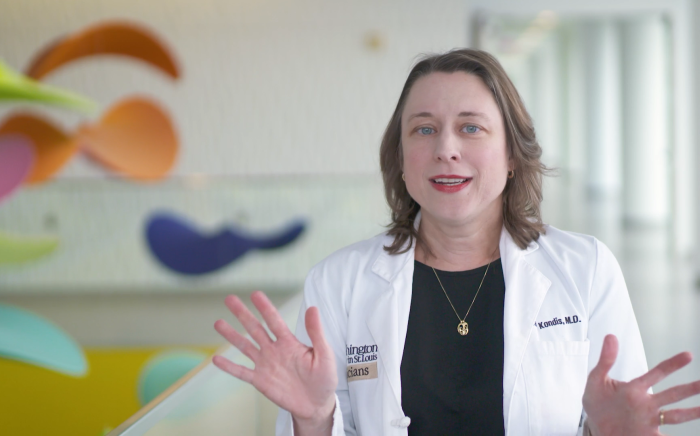The classic symptom of this disease is a port wine stain located on the child's face, typically near or around the eye and forehead areas. A port wine stain is present from birth and is a flat area on the child that varies in color from red to dark purple. The birthmark is caused by the formation of too many tiny blood vessels under the skin. There may also be associated brain abnormalities on the same side of the brain as the face lesion. Neurological changes that occur with this condition may include seizures, muscle weakness, changes in vision, and mental retardation. Glaucoma (a condition that causes increased pressure in the eye) may also be present at birth. Unlike tuberous sclerosis and NF, Sturge-Weber disease does not affect the other organs of the body.
The cause of Sturge-Weber is unknown. It is not thought to be passed down (inherited) through families.
Most cases of Sturge-Weber are not life-threatening. The patient's quality of life depends on how well the symptoms (such as seizures) can be prevented or treated.
Diagnosing Sturge-Weber disease
The diagnosis of Sturge-Weber is made with a physical examination and diagnostic tests. During the examination, the doctor obtains a complete prenatal and birth history of the child and asks if other family members are known to have any of these conditions. In older babies and children, the doctor will also ask about developmental milestones, since these disorders can be associated with other neurological problems and may require further medical follow-up.
Diagnostic tests may include:
-
Blood tests
-
Genetic testing.
Diagnostic tests that evaluate for conditions that have a tendency to run in families. -
X-ray.
A diagnostic test that uses invisible electromagnetic energy beams to produce images of internal tissues, bones, and organs onto film. -
Magnetic resonance imaging (MRI).
A diagnostic procedure that uses a combination of large magnets, radiofrequencies, and a computer to produce detailed images of organs and structures within the body. -
Computed tomography scan (also called a CT or CAT scan).
A diagnostic imaging procedure that uses a combination of X-rays and computer technology to produce horizontal, or axial, images (often called slices) of the body. A CT scan shows detailed images of any part of the body, including the bones, muscles, fat, and organs. CT scans are more detailed than general X-rays. -
Electroencephalogram (EEG).
A procedure that records the brain's continuous, electrical activity by means of electrodes attached to the scalp. -
Eye examination
-
Tissue sample of the tumor or skin lesion
Treatment
Specific treatment will be determined by your child's doctor based on:
-
Your child's age, overall health, and medical history
-
The extent of the condition
-
Your child's tolerance for specific medications, procedures, or therapies
-
Expectations for the course of the condition
-
Your opinion or preference
Since Sturge-Weber Disease is a lifelong condition that is not curable, the focus is on medically managing the symptoms. A child is best treated with an interdisciplinary team that may include the following health care providers:
-
Pediatrician/family practitioner
-
Neurologist.
A doctor who specializes in conditions of the brain, nerves, and spinal cord. -
Neurosurgeon.
A surgeon who specializes in operating on the brain and spinal cord. -
Orthopedic surgeon.
A surgeon who specializes in conditions of the muscles, tendons, ligaments, and bone. -
Ophthalmologist.
A doctor who specializes in conditions of the eye. -
Nurse
-
Rehabilitation team (physical, occupational, speech therapy, audiology)
Surgery may be needed to remove tumors that may be cancerous, as well as for cosmetic reasons.
Lifelong considerations
Since Sturge-Weber disease is a lifelong condition that is not correctable, management includes focusing on preventing or minimizing deformities and maximizing the child's capabilities at home and in the community. Positive reinforcement will encourage the child to strengthen his or her self-esteem and promote independence.
The full extent of the disease is usually not completely understood immediately after birth, but may be revealed as the child grows and develops.
Genetic counseling may be recommended by the doctor to provide information on the recurrence risks and any available testing.
To request an appointment with a physician at St. Louis Children's Hospital, call 314.454.5437 or 800.678.5437 or email us.












